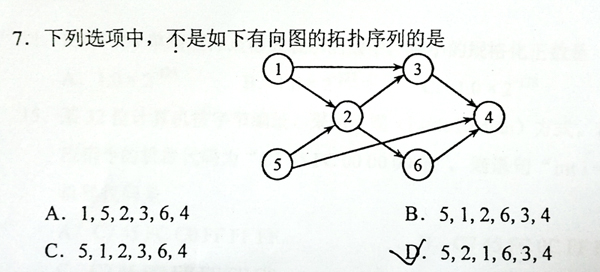This is a problem given in the Graduate Entrance Exam in 2018: Which of the following is NOT a topological order obtained from the given directed graph? Now you are supposed to write a program to test each of the options.

Input Specification:
Each input file contains one test case. For each case, the first line gives two positive integers N (≤ 1,000), the number of vertices in the graph, and M (≤ 10,000), the number of directed edges. Then M lines follow, each gives the start and the end vertices of an edge. The vertices are numbered from 1 to N. After the graph, there is another positive integer K (≤ 100). Then K lines of query follow, each gives a permutation of all the vertices. All the numbers in a line are separated by a space.
Output Specification:
Print in a line all the indices of queries which correspond to "NOT a topological order". The indices start from zero. All the numbers are separated by a space, and there must no extra space at the beginning or the end of the line. It is graranteed that there is at least one answer.
Sample Input:
6 8
1 2
1 3
5 2
5 4
2 3
2 6
3 4
6 4
5
1 5 2 3 6 4
5 1 2 6 3 4
5 1 2 3 6 4
5 2 1 6 3 4
1 2 3 4 5 6
Sample Output:
3 4
----------------------------------------
题目大意:
给定n个节点和m条有向边,判断给定的节点序列是否满足拓扑排序
解:
记录每个点的入度,对每个输入点判断入度是否为零。
细节:
vector<int>tr(in,in+1+n) 数组复制时考虑下标要相同
对于一组数据,用flag判断结果,注意中途输出和break是否会打乱逻辑,如本题当前组的数据还没有读完
#include<stdio.h>
#include<iostream>
#include<vector>
#include<stdlib.h>
#define maxn 1010
using namespace std;
int n, m, k;
vector<int>edge[maxn];
int in[maxn];
int main()
{
cin >> n >> m;
for (int i = 0, u, v; i < m; i++) {
cin >> u >> v;
edge[u].push_back(v);
in[v]++;
}
cin >> k;
int res = 0;
for (int i = 0; i < k; i++) {
int flag = 1;
int u; vector<int>tr(in, in + n + 1); // tr的下标要和in对应
for (int j = 0; j < n; j++) {
cin >> u;
if (tr[u]) {
flag = 0;
//break;此次不能break;上面还有cin>>u数据还没读完
}
for (auto z : edge[u])
tr[z]--;
}
if (1 == flag) continue;
printf("%s%d", res == 0 ? "" : " ", i);
res = 1;
}
// system("pause");
return 0;
}